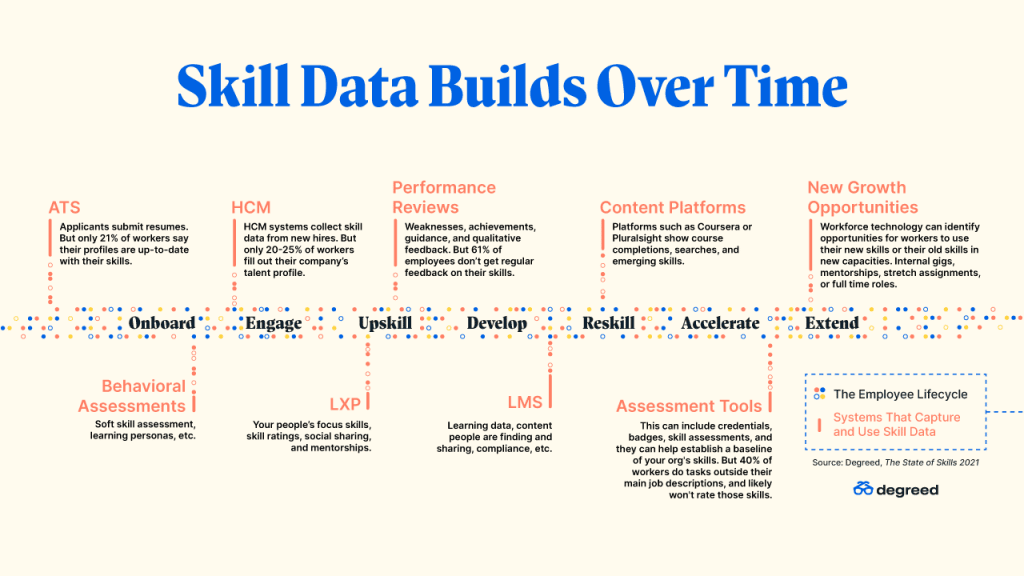When it comes to data, more is better. This doesn’t just mean more data points, it also means a more diverse set of data points. When building an organizational skills inventory, diverse data sets can ensure you are getting the most accurate and comprehensive view of the skills your org has and those it needs.
Companies that take a wide-angle approach to data collection — looking at inputs from a diverse range of sources, rating scales, and systems — cultivate what’s called a “signal advantage.” The result is a more expansive view of patterns, risks, and opportunities to act on. A signal advantage will allow you to build alerts around big shifts in your skill data to keep you ahead of change, and it all comes from diverse data.
Look at the graphic below. If you’re only looking at data from a single source, such as a human capital management (HCM) system, you’re seeing just a fraction of what’s happening across your company’s skills landscape. And it won’t tell you much about how the skill data at your organization is growing and evolving.

When skill data sources are mapped to the employee lifecycle, you can see how diverse skill data accumulates over time. You can use this visibility to build your skills inventory and help your people learn from the moment they onboard with your organization.
Tapping Into Skill Data Diversity
Learning transformation relies on several factors, but chief among them is skill data, according to HR Technologist. “The primary responsibility of L&D at any organization is first to identify which skills employees need to develop to stay relevant to the business objectives. Then, they need to build an appropriate program to close this skill gap.”
In Degreed, your skill landscape represents the skills your workers have, their proficiency levels, and what skills they are currently learning. And because our platform helps people learn continually, it captures data on your people’s development on an ongoing basis.
Key skill data inputs include:
- Skill ratings: These provide a wealth of data quickly, making them an ideal starting point. They take only seconds to complete; your people simply rate themselves for each skill numerically on a scale. In our example above, Maria chose to complete five skill rankings in areas relevant to her job.
Pro tip: You can use skill ratings to help establish a baseline skills inventory, but keep in mind that they’re subject to bias as a self-report.
- Skill assessments: These offer a higher level of objectivity because they’re rooted in demonstrable ability. They’re more reliable but take longer to complete, like a test. In our example, Maria only chose to assess the four most relevant skills to her job because it’s time-consuming.
Pro tip: It’s essential to think about the tools you’re using, how they speak to each other (or don’t), and how you can align them. Results conveyed through inconsistent terminology will muddy your data.
- Inferences: These go beyond rated or tested ability, reaching into all the key data points found within a professional career. They offer more insight into peripheral skills your workers might not choose to assess or rate. For instance, we know that Maria is interested in growing her SEO skills, even if she decided not to rate them. This can help connect her to appropriate stretch assignments or SEO mentors. It can also highlight relevant growth opportunities within the company.
Pro tip: Inferences can come from many sources, even before a new hire has started (think applications and ATS integration). Degreed software can pull inferences from resumes, job experience, and other convoluted documents to auto-populate the candidate’s profile with core skills as soon as he or she starts.
- Aggregated signals: Skill signals enable technology to make inferences. Signals can be any data that indicates what skills are growing and where. Content data, user data, activity data, and skill assessment data are all examples of signals. In our example above, we can see that Maria’s previous job responsibilities as a research coordinator informed several inferences about her skill sets.
Pro tip: Detecting a high number of these signals in a short amount of time can indicate a new trend that could help your company stay ahead of disruption and competition.
A Deeper Dive: Inferences and Signals
Today’s intelligent technologies can infer skills from sources like learning profiles, job applications, browser histories, course logins, and more — going further than ever before.
Take search engine optimization (SEO) skills, for example. If one of your people reads some articles about “SEO for beginners,” follows some SEO experts, and enrolls in an SEO course, an intelligent upskilling solution can aggregate these signals, interpret them, and infer that this person is a novice interested in learning about SEO. You now have this information even if that person never rated or assessed his or her SEO ability. That’s going to make your skills inventory more comprehensive, accurate, and useful.
Skill Data Doesn’t Have to be Overwhelming
If you want your organization to create real business value by connecting workforce learning to more holistic — and more helpful — information, it’s time to embrace an advanced skill data strategy. Whether you take it fast or slow, understanding what skill data is, where it comes from, and how to get it in abundance can open up a world of new information to your organization.
To help you get started, download The Ultimate Skill Data Handbook. Or contact Degreed to discuss skill data with us in more detail. We’d love to answer your questions.
